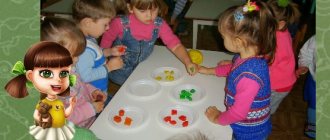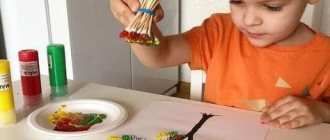One of the most significant activities in preschool age is play. Moreover, the child begins not only to take part in actions, but also to obey certain algorithms, rules, etc. This allows you to complicate the conditions over time, adding more and more new practical tasks.
Teaching numbers in a playful way can begin at 2-3 years of age.
Learning mathematics in a game
Educational games conducted by the parent with the aim of developing the child’s cognitive activity allow him to learn new knowledge and acquire the skills he needs in a simple and unobtrusive form. They perfectly develop fantasy and imagination, help the child remember and successfully put into practice forms of behavior. Thus, the child’s mental development reaches a qualitatively new level.
A game for a preschool child (especially when it comes to educational games) is not just entertainment. This is both labor and creative activity at the same time. Its role in the development of a child as an emerging personality cannot be overestimated. By directing and organizing the game, the parent can also include it in the pedagogical process, controlling all aspects of the child’s social development. A properly organized game is distinguished by the fact that it always has a specific goal, as well as the means necessary to achieve it.
The role of games in teaching preschoolers
This is especially evident in didactic games, which, among other things, have the goal of developing the child’s basic cognitive processes: attention, memory, and a general stock of ideas about the world around him. And despite the fact that the educational value of the didactic game is extremely small, it is indispensable for the prevention of socio-pedagogical neglect, preparing the child for school, etc.
Mastering mathematical concepts should be carried out strictly step by step. You need to move on to learning new material only after the previously learned material has been completely consolidated. In addition, the development of mathematical abilities and skills in preschool children must obey the strict principle of conformity with nature (each age has its own load).
“Formation of elementary mathematical concepts using educational games”
- development of accurate, reasoned and demonstrative speech, enrichment of the child’s vocabulary;
— development of children’s activity and initiative;
— fostering readiness for learning at school: developing independence, responsibility, perseverance in overcoming difficulties, coordination of eye movements and fine motor skills of the hands, self-control and self-esteem skills.
Currently, the following means of forming elementary mathematical concepts are widely used in the practice of preschool institutions::
— sets of visual teaching materials for classes;
— equipment for independent games and activities for children;
— methodological manuals for kindergarten teachers, which reveal the essence of the work on the formation of elementary mathematical concepts in children in each age group, and provide approximate lesson notes;
— a group of didactic games and exercises for the formation of quantitative, spatial and temporal concepts in preschoolers;
— educational and educational books for preparing children to master mathematics at school in a family environment.
The main teaching tool is a set of visual didactic materials for classes. It includes the following:
- environmental objects taken in their natural form: various household items, toys, dishes, buttons, cones, acorns, pebbles, shells, etc.;
— images of objects: flat, contour, colored, on stands and without them, drawn on cards;
— graphic and schematic tools: logical blocks, figures, cards, tables, models.
Developmental education technology
involves the interaction of a teacher and a child on the basis of collective distribution activities, the search for various ways to solve various problems through the organization of dialogue in the research and search activities of students.
Developmental education technology
includes stimulating the child’s reflexive abilities, teaching self-control and self-esteem skills.
In the last decade, issues of developmental education have been closely considered in connection with the integration of program tasks, the integration of different types of activities, this is especially typical for teaching preschoolers mathematics. At the same time, it is necessary to distinguish when mathematical activity is used as the main activity, and when, on the contrary, as a part (in art or musical activity, etc.).
The main form of work with preschoolers and their leading activity is play. Guided by one of the principles of the Federal State Educational Standard, the program is implemented using various forms specific to children of a given age group and, above all, in the form of a game.
Principles of organizing play activities for preschoolers
- A game for a preschooler should be based on generally accepted standards of morality and morality, and respect for the child’s personality.
- In no case should gaming activities in any way degrade the dignity of participants (including losers).
- A didactic game should help a child to comprehend the world around him as deeply as possible, assimilating the laws that it obeys.
Game lesson in mathematics in kindergarten
. In particular, the purpose of didactic games may be the development of mathematical abilities in preschool children. It will be much easier to do this through gaming activities.
How to use educational games to teach your child the basics of counting
Modern pedagogy is developing at a rapid pace. And more and more schools are beginning to use developmental technologies using computers in the learning process and recruit experimental classes. And the same can be safely said about family education.
Didactic games help develop mathematical abilities
It is no coincidence that a child’s early introduction to high technologies: computer and information literacy is a requirement of the modern rhythm of life. That is why, already in the preschool period, it is necessary to pay maximum attention to the formation of mathematical concepts and the basics of computer science. All these skills will definitely be useful to your child at school.
What should a child know by the time he enters first grade?
Despite the fact that mathematics is one of the basic school subjects, as well as the basis of many sciences that a child will begin to study in the future, it is this discipline that in many cases causes considerable difficulties for children. This is largely due to the fact that the mathematical mindset, which greatly facilitates the child’s perception of information of this type, is not inherent in all children.
However, there is a strictly defined system of knowledge and mathematical concepts that must be formed by the time the child enters school.
- Ability to count from zero to ten in both ascending and descending order
- Developed skill of recognizing numbers in a series (even if they are placed separately)
- Formed ideas about cardinal and ordinal numbers
- Formed ideas about the previous and subsequent numbers within ten
- Knowledge of basic geometric shapes and the skill of recognizing them (understanding the features that distinguish a triangle, circle, square, etc.)
- Having an idea of the whole and the parts; the ability to divide an object into 2 and 4 equal parts.
- Ability to use sticks, strings and some other measuring devices to estimate body parameters such as length, width and height
- The ability to compare objects into categories of more-less, higher-lower, wider narrower.
Category knowledge game
Development of mathematical abilities through didactic gamesconsultation
Consultation for parents.
Development of mathematical abilities through didactic games.
In preschool age, play is of utmost importance in the life of a small child. The need for play in children continues and occupies a significant place even during the first years of their schooling. In games there is no real conditioning by circumstances, space, time. Children are the creators of the present and the future. This is the charm of the game.
Have you heard the following parable: “I tried to reach the child’s heart with words, but they often passed by him unheard. I tried to reach his heart with books, he gave me puzzled looks. In despair, I turned away from him. “How can I get to this child’s heart? “I exclaimed. He whispered in my ear: “Come play with me!” »
Learn by playing! In order for young children to master the necessary movements, speech, and various skills, they must be taught this.
Didactic games were created to teach children. Their main feature is that the task is presented to the child in a playful way. Children play without suspecting that they are mastering some knowledge, mastering the skills of operating with certain objects, and learning a culture of communication with each other. Any didactic game contains cognitive and educational game components and game actions. The selection of didactic games for teaching children mathematics is carried out in accordance with program requirements. Each didactic game should be aimed at solving a particular educational problem. The didactic game only partly meets the requirements of a complete systematic knowledge: sometimes it is an “explosion of surprise” for children from the perception of something new, unknown; sometimes the game is “search and discovery”, and always the game is joy, the children’s path to their dreams. Filling learning with emotional and cognitive content is a feature of the didactic game.
Mathematics plays a huge role in mental education and in the development of a child’s intelligence. Currently, in the era of the computer revolution, the common point of view expressed in the words: “Not everyone will be a mathematician” is hopelessly outdated. We must remember that mathematics is one of the most difficult academic subjects. Therefore, one of the most important tasks of educators and parents is to develop a child’s interest in mathematics in preschool age. Introducing this subject in a playful and entertaining way will help the child in the future to master the school curriculum faster and easier. Mathematics has a unique developmental effect. Its study contributes to the development of memory, speech, imagination, emotions; forms perseverance, patience, and creative potential of the individual. A “mathematician” plans his activities better, predicts the situation, expresses his thoughts more consistently and accurately, and can clearly justify his position.
Parents think that kindergarten is not such an important event in their children’s lives. Many parents believe that the main thing when preparing for school is to introduce the child to numbers and teach him to write, count, add and subtract. The stock of memorized knowledge ends very quickly, and the lack of formation of one’s own ability to think productively (that is, to independently perform the above-mentioned mental actions on mathematical content) very quickly leads to the appearance of “problems with mathematics.” Children, regardless of age, are involved in solving simple creative problems: finding, guessing, revealing a secret, composing, modifying, matching, modeling, grouping, expressing mathematical relationships and dependencies in any available way. Children develop the ability to find the answer to the constant question: “how?” One of the important directions in solving this problem is the creation of conditions that ensure the full mental development of children, associated with the formation of stable cognitive interests, abilities and skills of mental activity, mental qualities, creative initiative and independence.
With the help of didactic games, the teacher teaches children to think independently and use the acquired knowledge in various conditions in accordance with the task. A didactic game allows you to individualize work, give tasks that are feasible for each child, taking into account his mental and psychophysical capabilities, and maximize the development of each child’s abilities. The child’s attention is focused on the game, on completing game tasks, and meanwhile he overcomes difficulties of a mathematical nature, transfers his existing knowledge to a new environment.
Thus, didactic games make it possible to provide the required number of repetitions on a variety of material, constantly supporting and maintaining a positive attitude towards the mathematical task, which is embedded in the content of the game.
When using didactic games, various objects and visual material are widely used, which helps ensure that classes are held in a fun, entertaining and accessible way.
Didactic games for the formation of mathematical concepts are conventionally divided into the following groups:
1. Games with numbers and numbers
2. Time travel games
3. Space navigation games
4. Games with geometric shapes
5. Logical thinking games
These games can be presented in different forms, be it printed board games, verbal games (assignments, riddles, conversations, sentences), or plot games.
When using didactic games, I use a variety of objects and visual material, which helps ensure that the lessons are fun, entertaining and accessible. To form elementary mathematical concepts in preschoolers, I use various types of didactic games, for example:
1. Games with objects: “Assemble a pyramid”, “Assemble a matryoshka doll”, “Build a turret”, etc. The purpose of these games is to help consolidate the qualities of objects (size, shape, color).
2. Games for sensory development:
- to fix the color of an object: “Multi-colored beads”, “Put a bouquet in a vase”, “Let’s treat the bear with a berry”, etc. By playing these games, children learn to group and correlate objects by color.
- to fix the shape of an object: “Assemble a pyramid? ”, “Circle, Square”, “Patches for the rug”, “Mand your pants”, etc. In these games, children learn to distinguish, group objects by shape, and insert objects of a given shape into the holes corresponding to them.
- to consolidate the size of an object: “Big and small”, “Which ball is bigger”, “Let’s treat the bear”, etc. These games teach children to distinguish, alternate, and group objects by size.
The development of children's cognitive activity, their curiosity, and the desire for independent search is one of the main tasks in the development of a preschool child. Experience working with children of senior and junior preschool age shows that with the correct, systematic and creative use of didactic games with mathematical content and universal didactic material, significant progress in the development of cognitive activity can be achieved.
In my opinion, didactic games with mathematical content are of great importance for the successful involvement of a child in serious educational activities, for a better understanding and consolidation of mathematical material, for the development of cognitive activity in children
Does a preschooler need computer science?
Despite the fact that today computer science is an optional discipline that is not included in the category of compulsory subjects, some ideas about computer science should be formed in the child by this time. For example:
- Knowledge about algorithms.
- An initial introduction to computers.
- Understanding the program used to control a computation.
- Basic skill in using algorithms and logical operations using And, Or, Not commands.
Initial acquaintance with computers for preschoolers
Basics of mathematical concepts in preschool age
Mastering mathematical knowledge is impossible without the child understanding such fundamentals of science as quantity, number, etc. However, given that for a child they remain abstract for a long time, understanding even the simplest categories at first glance can be significantly difficult.
In these cases, it is possible to develop mathematical abilities in preschool children through play activities.
Simple didactic games give the child the opportunity to understand what a number is and form adequate spatial-temporal ideas. In order for games to have maximum effect, it is necessary to build them on the basis of the following principles.
For a child to effectively master the skills acquired during games, it is necessary that visual material be used in classes: bright pictures, toys, cubes, etc. This is explained by the fact that the voluntary attention of preschoolers is not yet well developed. And to activate it, it is necessary that the object be distinguished by such qualities as brightness, novelty and contrast. In addition, favorite toys used during classes will make them even more interesting and exciting.
Geometric cards develop spatial understanding
For example, if a child has some difficulty in counting, you can put in front of him several geometric shapes painted in different colors and sequentially count the objects in each of them. In order for the child not to become attached to specific things and to be able to transfer the acquired knowledge to different objects, it is very advisable to use new toys in the learning process, supplementing the existing stock with new ones.
In everyday life, you should also encourage the child to name the number of objects on the table, the number of cars in the yard, children on the playground, etc.
After a child learns to count, parents will be able to significantly expand his stock of everyday knowledge by explaining the purpose of certain objects. For example, thanks to counting skills, it will not be difficult for a child to explain why a person needs a watch or a thermometer. And subsequently understand by the clock, at any moment, telling the time or measuring the temperature.
By school almost all children can count
A fairy tale is also an indispensable tool for developing mathematical concepts in a child. You can use lesson elements in an unobtrusive form, including them in the process: for example, when reading a fairy tale, you can ask the child how many characters he counted in it; how many animals, birds, trees are shown in the picture of the illustrated book. It is also useful to invite the child to compare characters, pointing out their similarities and differences; indicating who is more or less of them, higher or lower, etc. Operations with numerals can be performed within the first ten.
A significant role in the development of addition and subtraction skills in the future will be played by the child’s ability to divide a whole object into parts.
In order for the child to effectively learn the concept of quantity, as well as the previous and subsequent numbers, you can play with him, for example, by asking him to guess the number within certain limits and giving him hints with words more or less. This will allow the child to better navigate numbers and compose complete number series in his mind.
Children love to play with counting sticks
Ordinary counting sticks can also make a significant contribution to the development of a child’s mathematical understanding.
Here are just some examples of didactic games using these items:
- Lay out the counting sticks in front of the child and invite him to first choose any two, and then distribute them on two sides. After this, the child must say how many sticks are on each side.
- Over time, the conditions of the game can be slightly complicated by asking the child to divide four sticks into two parts. And then suggest other ways to divide the four sticks into two groups. Subsequently, the number of sticks can be increased to 10. Increasing the number of sticks will give the child more scope for imagination, offering more and more new ways of division.
- You can make simple geometric shapes from sticks, thereby explaining to your child what a triangle, rectangle, or square is. Once your child has an understanding of angles, you can explain the differences between shapes in more detail. And also invite him to fold them from sticks on his own.
- Over time, classes on forming simple geometric concepts can be complicated by asking the child to fold, for example, a rectangle with a side of 3 or 4 sticks. Or make different shapes from the same number of sticks.
- It is also useful to offer the child a fixed number of sticks, from which he could assemble two figures, or figures that have one common side.
- Counting sticks are also great for making simple numbers and letters. Using this method also prepares the child well for working with the lined surface of a notebook.
Development of elementary mathematical concepts through intellectual games.
Long before play became a subject of scientific research, it was widely used as one of the important means of raising and teaching children.
Play is a need of a growing child's body.
For preschool children, play is of exceptional importance: play for them is study, play for them is work, play for them is a serious form of education.
Games that promote the development of perception, attention, memory, thinking, and the development of creative abilities are aimed at mental development in general.
Intellectual games differ in educational content, cognitive activity of children, game actions and rules, organization and relationships of children, and the role of the teacher. The listed features are inherent in all games, but in some, some are more pronounced, in others, others.
Under no circumstances should disciplinary measures be taken against children who violate the rules of the game or the game atmosphere. This can only be a reason for a friendly conversation, an explanation, or even better, when, having gathered together, the children analyze, figure out who showed themselves in the game and how the conflict should have been avoided.
Examples of games to develop mathematical concepts in preschoolers.
Intellectual games are conventionally divided into the following groups:
- Games with numbers and numbers
- Time travel games
- Space navigation games
- Games with geometric shapes
- Logical thinking games
The first group of games includes teaching children to count forward and backward. Using a fairy tale, children are introduced to the formation of all numbers within 10 by comparing equal and unequal groups of objects. Two groups of objects are compared, located either on the lower or on the upper strip of the counting ruler.
Didactic games such as “Think of a number”, “Number what is your name?”, “Make a sign”, “Make a number”, “Who will be the first to name the toy that is missing?” and many others are used in classes in their free time, with the aim of developing children's attention, memory, and thinking.
The second group of mathematical games (time travel games) serves to introduce children to the days of the week. It is explained that each day of the week has its own name. In order for children to better remember the names of the days of the week, they are indicated by circles of different colors. Observation is carried out for several weeks, indicating each day with circles. This is done specifically so that children can independently conclude that the sequence of days of the week is unchanged. Children are told that the names of the days of the week indicate which day of the week it is: Monday is the first day after the end of the week, Tuesday is the second day, Wednesday is the middle of the week, Thursday is the fourth day, Friday is the fifth. After such a conversation, games are offered to reinforce the names of the days of the week and their sequence. Children enjoy playing the game “Live Week.”
The third group includes games for spatial orientation. Children's spatial representations are constantly expanding and strengthened in the process of all types of activities. The teacher’s task is to teach children to navigate in specially created spatial situations and determine their place according to a given condition. With the help of didactic games and exercises, children master the ability to determine in words the position of one or another object in relation to another. There are many games and exercises that promote the development of spatial orientation in children: “Find a similar one”, “Tell me about your pattern”, “Carpet workshop”, “Artist”, “Travelling around the room” and many other games. By playing the games discussed, children learn to use words to indicate the position of objects.
To consolidate knowledge about the shape of geometric shapes, children are asked to recognize the shape of a circle, triangle, and square in surrounding objects. For example, the question is: “What geometric figure does the bottom of the plate resemble?” (table top surface, sheet of paper, etc.). A lotto type game is played. Children are offered pictures (3-4 pieces each), in which they look for a figure similar to the one being demonstrated. Then, the children are invited to name and tell what they found.
The use of these didactic games helps to consolidate children's memory, attention, and thinking.
Let's consider didactic games for the development of logical thinking. At preschool age, children begin to develop elements of logical thinking, i.e. The ability to reason and make your own conclusions is formed. There are many intellectual games and exercises that influence the development of creative abilities in children, as they have an effect on the imagination and contribute to the development of non-standard thinking in children. These are games such as “Find a non-standard figure, how are they different?”, “Mill”, and others. They are aimed at training thinking when performing actions.
Intellectual play in kindergarten is an opportunity to reveal a child’s creative potential and nurture a creative personality.
Games where you need to look for the same properties or signs of objects: “Wonderful bag”, “Identify the object by touch”, “Find an object that distinguishes it from others”. In such games, the child learns to reason and be attentive.
To develop intellectual abilities, children play a game such as “I know five...”. She teaches to classify and generalize. These are tasks for finding a missing figure, continuing a series of figures, signs, and finding numbers. Getting acquainted with such games begins with elementary tasks on logical thinking - a chain of patterns. In such exercises there is an alternation of objects or geometric shapes. Children are asked to continue the row or find the missing element.
In addition, tasks are given of the following nature: continue the chain, alternating squares, large and small yellow and red circles in a certain sequence. After children learn to perform such exercises, the tasks become more difficult for them. It is proposed to complete a task in which it is necessary to alternate objects, taking into account both color and size.
Modern society lives in the era of the development of computer and nanotechnology. And therefore, modern children should be intellectually developed individuals. Effective development of the intellectual abilities of preschool children is one of the pressing problems of our time. Preschoolers with developed intelligence remember material faster, are more confident in their abilities, adapt more easily to a new environment, and are better prepared for school. Intellectual work is very difficult, and taking into account age characteristics, we must remember that the main method of development is problem-based and search, and the main form of organization is play. A game is a huge bright window through which a life-giving stream of ideas and concepts about the world around us flows into the child’s spiritual world. Play is the spark that ignites the flame of inquisitiveness and inquisitiveness.” For preschoolers, play is of great importance: play is learning, play is work, play is a serious form of education, as well as a way of understanding the world around them.
Preparing your hand for writing. Working with notebooks
Before you start teaching your child to write numbers, it is necessary to carry out significant preliminary preparation with him. In particular, he must clearly understand what a notebook cell is, what its boundaries are, and find the corners, middle and sides.
After the child begins to freely navigate the lined surface, it will be possible to move on to drawing simple ornaments, for example, connecting opposite corners of the cage, or points located in the middle.
Preparation for writing includes various exercises
No matter how strong the parent’s desire to teach the child to write as quickly as possible and prepare his hand for writing numbers, it is very desirable that in one lesson he learns no more than one or two patterns. The benefit of such activities is not only that the child prepares to write more complex elements, but also perfectly develops fine motor skills.
Logic games in preschool age
The development of mathematical abilities in preschool children through gaming activities is impossible without the use of logical games. Among other things, logic games stimulate the child to look for non-standard and unusual solutions, develop creative thinking in him, and support his desire to continue learning.
Logic game for preschoolers
Entertaining tasks are valuable because they unobtrusively lead the child to the conclusion that concentration and concentration are necessary to complete a task that is interesting to him. This makes it possible not only to develop thinking, but also to polish voluntary attention. This will give the child the opportunity to perceive the conditions of the task and look for a possible catch in it. Thus, the development of mathematical abilities of preschool children through gaming activities is carried out as unobtrusively and correctly as possible.
You need to read the problems out loud, slowly and clearly so that the child can draw conclusions from each sentence and understand it correctly. It is very undesirable to give the child too many explanations: he must independently assimilate the train of thought. This will greatly enhance the joy of discovery.
Simple and familiar riddles from childhood will also play an irreplaceable role in the process of logic development: this will give the child the opportunity to learn to identify the key features of objects and recognize them by them.
Games for mastering the basics of computer science
Despite the fact that computer science is still not a subject compulsory for study at primary school age, studying its fundamentals greatly contributes to the development of forms of abstract thinking. It also helps to master such actions as classifying objects according to certain criteria, ranking, distinguishing between the main and the secondary. The child begins to learn to assimilate established rules and strictly adhere to them.
To master basic concepts of computer science, you can use board games, which are sold today in all children's stores.
Computer games for preschoolers develop abilities
The meaning of most board games for children is quite simple: with the help of chips and a cube, the child moves around the playing field. Thanks to this, spatio-temporal relationships are formed, the ability to follow given instructions, and carry out sequential actions. The child learns the simplest conditions and algorithms. It is desirable that board games be complemented by a plot that is interesting for the child, thoughtful design and interesting graphics.







